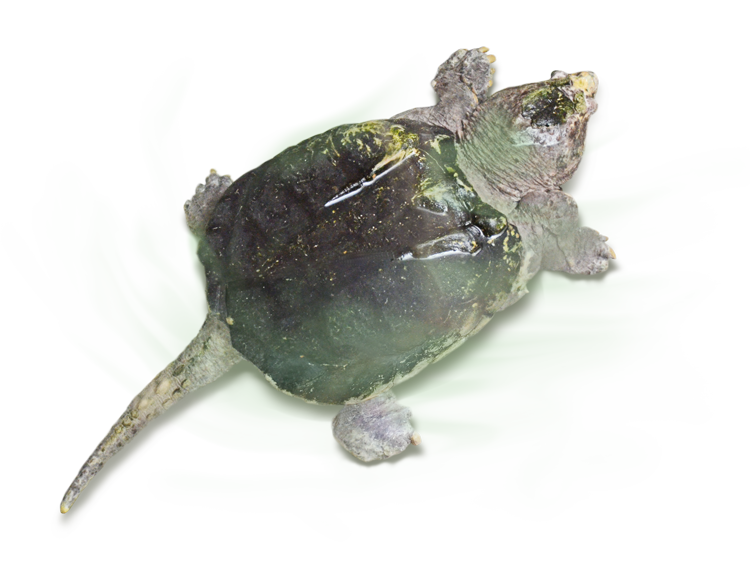
Macrochelys temminckii (Troost, 1835)
擬餌を巧みに使う古代ガメ
The Ancient Turtle That Masters the Art of Luring
最大で甲長は80cm、体重は100kgを超えます。北アメリカ原産のカミツキガメの仲間ですが、一種のみでワニガメ属を形成し、系統的にもきわめて貴重な存在です。
生涯の大半を水中で過ごし、魚などの水生生物を主な餌とし、貝や小型のカメなどの堅いものでも、強靭な顎をもつ嘴で噛み砕いて食します。餌の獲り方は独特で、水底で口を大きく開けて待ち伏せをし、舌にあるピンク色のミミズのような突起を動かして魚をおびき寄せ、近づいた瞬間に素早く首を伸ばして捕食します。このような擬似餌を使った捕食行動は「ルアーリング」と呼ばれ、一部のヘビやカエルでも見られますが、ワニガメのルアーリングはとりわけ巧みで、本物のミミズの動きを見事に再現しています。
ワニガメはカミツキガメ科に属しますが、外見は大きく異なります。甲羅には3本の隆起(キール)があり、これはカミツキガメには見られません。また、ワニガメは陸上では腹を這わせて移動しますが、カミツキガメは脚が長く体を持ち上げて歩きます。ワニガメの険しく隆起した鋸状のキール、厚く硬い皮骨、そして長く伸びた尾は、現生カメの軽量化された骨格構造とは異なり、古代ガメに最も近い特徴を示します。この形態が数千万年もの間ほとんど変化していないことから、「生きた化石」と呼ばれています。
このように長きにわたり形態がほぼ変化しない現象を「進化的停滞(stasis)」といい、サメ、シーラカンス、カブトガニ、ワニ類などにも見られます。彼らは進化から取り残されたのではなく、環境に適応した完成形であったため変化を必要としなかったのです。ワニガメもまた、「底でじっと待ち伏せる巨大捕食者」という戦略を確立し、進化的完成を得たがゆえに、他のカメのように軽量化や遊泳適応、陸上適応といった方向へ変化する必要がなかったのです。
The alligator snapping turtle can reach a carapace length of up to 80 cm and weigh over 100 kg. Native to North America, it belongs to the snapping turtle family but is the sole member of the genus Macrochelys, making it taxonomically unique and valuable.
It spends most of its life in the water, feeding on fish and other aquatic animals. With its powerful, beak-like jaws, it can crush even hard-shelled prey such as mollusks and small turtles. Its method of hunting is distinctive: it lies motionless on the bottom with its mouth wide open, wriggling a pink, worm-like appendage on its tongue to lure fish closer. When the prey approaches, the turtle strikes swiftly and captures it. This use of a deceptive lure is known as “luring,” a behavior also observed in certain snakes and frogs, but the alligator snapping turtle performs it with remarkable precision, perfectly imitating the movement of a real worm.
Although it belongs to the same family as the common snapping turtle, its appearance differs greatly. The alligator snapping turtle’s shell bears three pronounced ridges, or keels, which are absent in its relative. It crawls flat-bellied on land, while the common snapping turtle walks with its body raised on long legs. Its jagged, rugged keels, thick osteoderms, and long, muscular tail are reminiscent of ancient turtles, giving it the title of a “living fossil.” Its overall morphology has remained virtually unchanged for tens of millions of years.
Such long-term morphological stability is known as evolutionary stasis, a phenomenon also seen in sharks, coelacanths, horseshoe crabs, and crocodilians. These animals are not relics left behind by evolution but species so perfectly adapted to their environments that further change was unnecessary. Likewise, the alligator snapping turtle, having perfected its strategy as a massive ambush predator lying in wait on the riverbed, achieved an evolutionary completion—there was simply no need to change.
参考文献
天王寺動物園情報誌『なきごえ』Vol.57-03, 2021年7月夏号 |ワニガメ 2025年11月8日閲覧
東京ズーネット | ニュース | 特設展示「両生類爬虫類のえさの食べ方 捕え方」開催中! ワニガメの捕食行動とは? | (2015年4月17日) 2025年11月8日閲覧